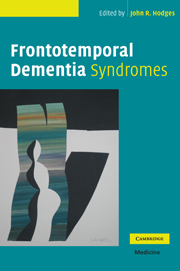Book contents
- Frontmatter
- Contents
- List of contributors page
- Preface
- 1 Overview of frontotemporal dementia
- 2 Epidemiology of frontotemporal dementia
- 3 Clinical presentations of frontotemporal dementia
- 4 Overlap syndromes
- 5 The neuropsychology of frontotemporal dementia
- 6 Neuroimaging and other investigative findings
- 7 The histopathology of frontotemporal dementia
- 8 Molecular neuropathology in familial and sporadic frontotemporal dementia
- 9 The genetics of frontotemporal dementia
- 10 Psychological interventions in frontotemporal dementia
- Index
8 - Molecular neuropathology in familial and sporadic frontotemporal dementia
Published online by Cambridge University Press: 05 August 2016
- Frontmatter
- Contents
- List of contributors page
- Preface
- 1 Overview of frontotemporal dementia
- 2 Epidemiology of frontotemporal dementia
- 3 Clinical presentations of frontotemporal dementia
- 4 Overlap syndromes
- 5 The neuropsychology of frontotemporal dementia
- 6 Neuroimaging and other investigative findings
- 7 The histopathology of frontotemporal dementia
- 8 Molecular neuropathology in familial and sporadic frontotemporal dementia
- 9 The genetics of frontotemporal dementia
- 10 Psychological interventions in frontotemporal dementia
- Index
Summary
Introduction
Frontotemporal dementia (FTD) is heterogeneous in terms of clinical presentation and pathological features. From the pathological point of view, subtypes of FTD are defined on the pattern of protein accumulation in the brain and they are collectively referred to as frontotemporal lobar degeneration (FTLD; Table 8.1). In general, FTLD is classified as tau–positive and tau-negative. The tau-positive cases show inclusions made of insoluble aggregates of the microtubule–associated protein tau. The tau-negative cases represent about 50–66% of all FTLD cases (Table 8.1) and could be divided in three groups: (1) those characterised by the presence of ubiquitin-positive, tau-negative intraneuronal inclusions; (2) FTLD cases with intraneuronal cytoplasmic inclusions made of neurofilament and internexin protein (i.e. neuronal intermediate filament inclusion disease, NIFID); (3) FTLD cases in which none of these kinds of inclusions are present (i.e. dementia lacking distinctive histology, DLDH).
The majority of FTD cases are sporadic, but about 40%of patients have a positive family history of dementia (Rosso et al. 2003). Numerous mutations in the tau gene on chromosome 17 have been identified and account for 10–40% of familial FTD. These cases are defined as frontotemporal dementia and parkinsonism linked to chromosome 17 (FTDP–17; Foster et al., 1997) and are invariably characterised by tau-positive pathology. Recently, mutations in the progranulin (PRGN) gene on chromosome 17 have been reported in several FTD kindreds (Baker et al., 2006; Cruts et al., 2006). Progranulin mutations account for about 26% of familial FTD in the Belgian population (Cruts et al., 2006) and are associated with ubiquitinpositive tau-negative pathology (Baker et al., 2006; Cruts et al., 2006). Genetic analyses of other cases of hereditary FTD uncovered significant linkage to loci on different chromosomes, but the causative genes have not yet been identified.
While a vast literature is available on the pathology and primary pathogenic mechanisms of FTDP-17, little is known about other hereditary and sporadic FTLD cases. Therefore, the main part of this chapter will cover FTDP-17 molecular pathology and mechanisms. After a brief overview on the biology of tau protein, we will present the different types of mutations reported in the tau gene and their primary molecular mechanisms in relation to the type of fibrillar deposits they are associated with. We will discuss how knowledge gained on genetic cases of FTDP-17 highlights basic neurodegenerative mechanisms that could also apply to sporadic FTLD.
- Type
- Chapter
- Information
- Frontotemporal Dementia Syndromes , pp. 208 - 256Publisher: Cambridge University PressPrint publication year: 2007



